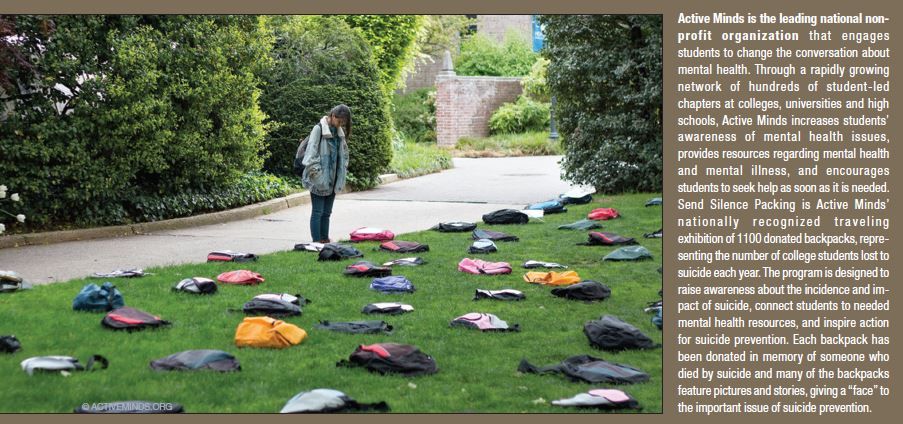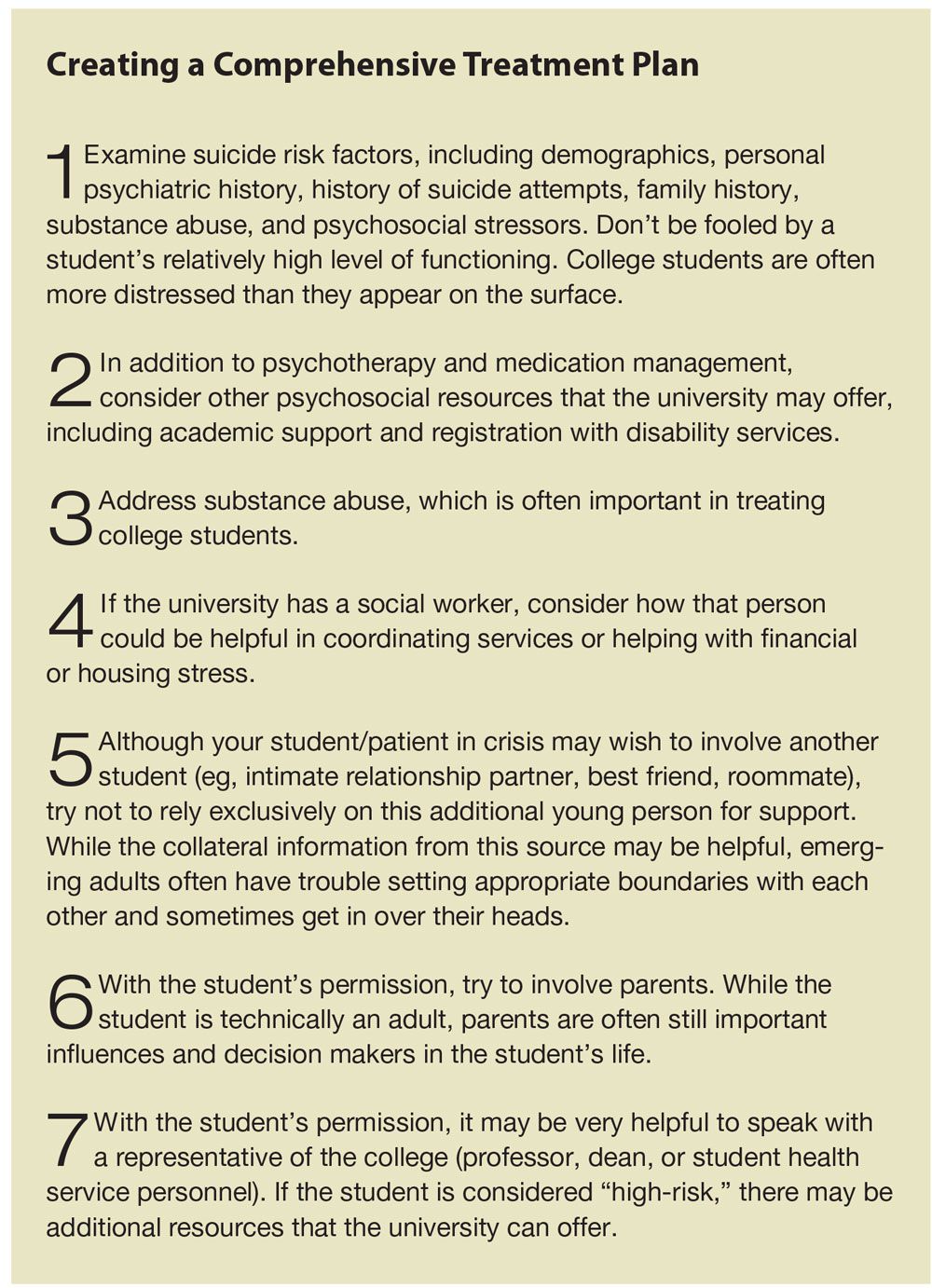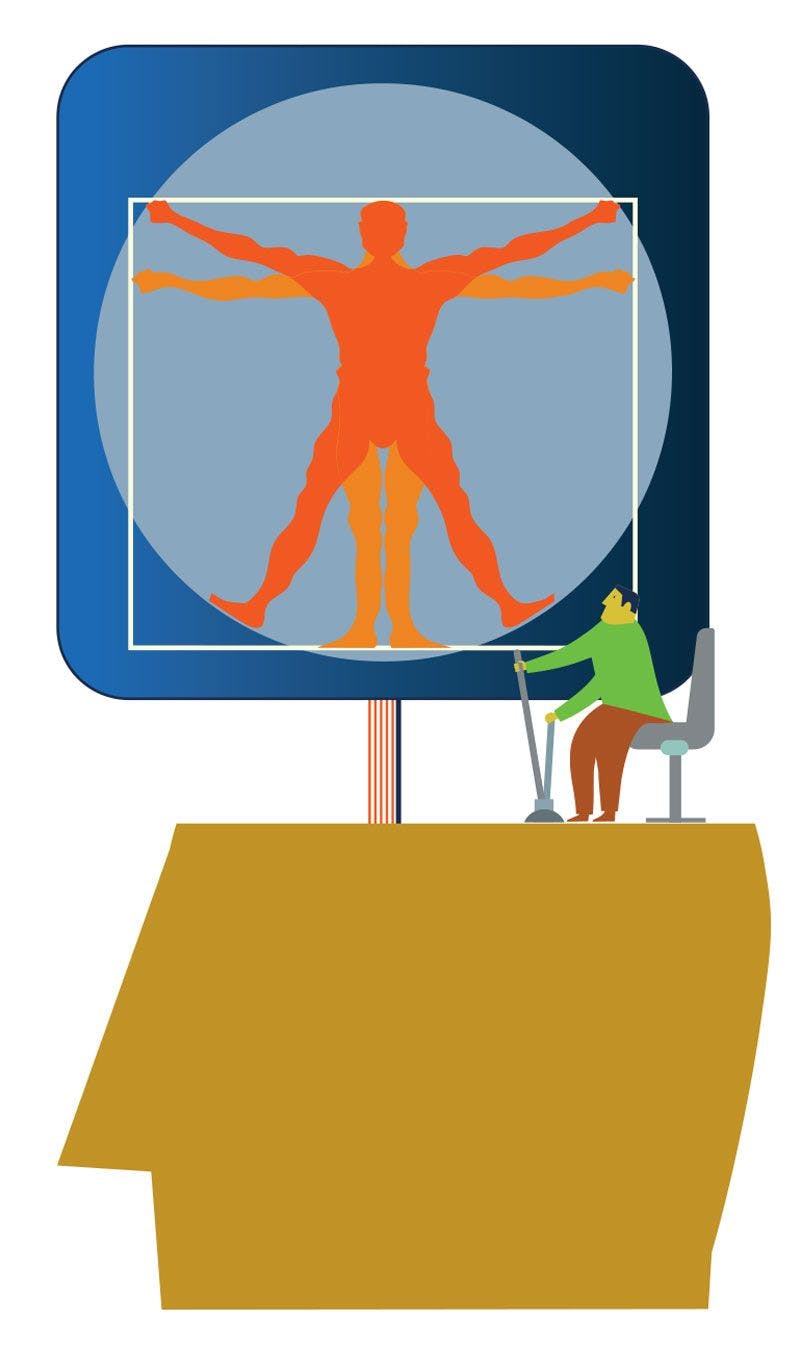Publication
Article
Psychiatric Times
Managing the Suicidal College Student: Advice for Community Providers
Author(s):
Although college students are in many ways similar to any patient in their age group, their environment and stressors differ in significant ways. The authors identify issues to consider in assessing and managing suicidality in this population.
Active Minds is the leading national nonprofit organization...

Creating a Comprehensive Treatment Plan

Any suicide is a tragedy, but the suicide of a college student-just on the brink of entering independent adulthood-is particularly heartbreaking. We know the statistics: in the past year, 8% of students seriously considered suicide and 1.3% attempted to end their lives1[PDF]; suicide is the 2nd leading cause of death among college students.2[PDF] Although counseling centers are ubiquitous on college campuses, students often don’t seek out help for their problems, and when they do, they may be referred to off-campus providers for ongoing care.3[PDF] Since counseling centers have a responsibility to serve the entire college community, they often need to triage and refer students who require intensive or ongoing services. It is therefore not uncommon for psychiatrists in the community to encounter college students in serious distress in their practices.
Although college students are in many ways similar to any patient in their age group, their environment and stressors differ in significant ways. Psychiatrists who treat students outside the campus mental health system may not be aware of the particular resources offered by campuses and also some of the impediments to ideal care. What follows is a brief primer on some of the issues to consider in assessing and managing suicidality in college students, as well as an introduction to some of the resources available on campuses to supplement outside treatment.
CASE VIGNETTE
Jane is a 20-year-old junior college student who presents with symptoms of severe depression and suicidality in the context of failing 2 of her classes and being placed on academic probation. She is the first in her family to attend college-she transferred to a 4-year state university after completing her first 2 years of higher education in a community college. She worries that her academic performance will put her financial aid in jeopardy, and she does not want to tell her parents about her situation. She has a history of major depression and was hospitalized at age 16 after an overdose. She is part of a sorority and acknowledges that she drinks too much on weekends. She has a family history of depression and a cousin who completed suicide. She lives on campus with 2 roommates.
Assessing suicide risk
Suicide risk factors are the same in college students as for anyone else, and Jane has several: a history of major depression, a past suicide attempt, excessive alcohol intake, and a family history of completed suicide. In addition, psychosocial stressors, including the pressure to succeed in college, financial stress, and academic failure, raise the level of concern. These psychosocial stressors add up and have severe consequences beyond the moment: inability to complete college, whether for academic or financial reasons, can have downstream effects on job prospects, future earnings, and even identity as part of the middle class.
Jane’s substance use puts her at increased risk for suicide. There is widespread recognition of the negative effects of underage drinking, and a public-health push on campuses to prevent substance abuse. In fact, all campuses that receive federal funds are subject to the Drug-Free Schools and Communities Act, a 1990 federal act that requires institutions of higher education to “design, develop and implement alcohol and other drug prevention programs for students and employees and to critically evaluate their programs on a biennial basis.”4 Unfortunately, treatment programs lag behind prevention, and students must often rely on community programs (eg, Alcoholic Anonymous) or insurance-based interventions.
Given the severity of her history, Jane would benefit from an ongoing relationship with a psychiatrist who could follow her through the remainder of her college career. While the college counseling center may be most convenient, on-campus services are often short-term. It is therefore not at all unusual for a student like Jane to be treated by a community psychiatrist who accepts the student’s health insurance.
Access to care
Students seeking psychiatric services may be confused about their options for treatment, including on- and off-campus services, and free versus insurance-based services. Campus health services are generally funded-entirely or in part-by student fees and may also bill third-party payers. When campuses provide services for free, there is generally a time limit, and longer-term treatment is referred out to community providers.
Before the Affordable Care Act (ACA), many young adults had significant gaps in health insurance coverage, and institutions began offering institution-specific plans for enrolled students. With the implementation of the ACA, however, the landscape of student health is shifting. Now that students can be covered on their parents’ health plans until age 26 years, many undergraduates arrive on campus with health insurance for which the preferred providers are outside the campus health system. In practice what this means is that community psychiatrists who accept the parents’ insurance may become first-choice providers for students in distress. It also means that community providers need to become familiar with campus structures and supports.
Financial stress from paying for higher education
For Jane, academic success is essential not only to please herself and her family, but also to maintain her financial aid and therefore her housing and health insurance. It sets the stage for her future employment options too. Understanding the interdependence of these factors is key to helping Jane manage her situation.
Although taking a reduced course load or a leave of absence from school might be the best option for her depression, these choices must be considered in the context of their overall consequences for her life. Jane’s fear that reducing her course load would negatively affect her financial aid is not unfounded; in many universities, federally based financial aid is contingent on taking a minimum number of credit hours and maintaining a certain grade point average.
Financial aid is also given with time-to-degree pace limits, and students who complete their course work too slowly may later find themselves ineligible for further aid. This too has serious consequences, as the remaining options include dropping out of school, adding a job to help with finances (but affecting academic time), or seeking loans from private institutions. Since institutions of higher education may not qualify for aid when their students have excessive loan default rates, they are under increasing pressure to set their own rules on time to degree.5
Academic support
Most campuses offer academic support beyond the classroom. Peer tutoring and writing support are available on most campuses, and learning centers provide workshops on effective study skills, time management, and test-taking strategies. Health, counseling, and wellness programs help with strategies to manage test anxiety, particularly around exam time, and many campuses offer creative anti-stress programming, such as having dogs visit on campus or organizing “scream-fests.”
Many students, including those with depression and anxiety, may qualify for accommodations through the school’s disability services. The Americans With Disabilities Act mandates that campuses are responsible for providing “reasonable workplace” accommodations to their disabled students.6 Schools that receive federal financial aid (almost all public and private institutions) are also subject to the regulations of Section 504 of the Rehabilitation Act.7 In practice, this means that students with diagnosed mental illness may be able to receive extended testing time, note-taking assistance, priority registration, and other help that might ease their day-to-day burden. Disability services often require validation of a disabling medical condition from a mental health or medical provider-documentation that differs from what is required for social security or department of rehabilitation disability.
Confidentiality
In treating college students, questions inevitably arise about communication with members of the university community (eg, professors, deans, financial aid staff, disability services staff, social workers) and with parents. While psychiatrists are accustomed to practicing within the framework of the federal Health Insurance Portability and Accountability Act (HIPAA), confidentiality in a campus setting differs slightly from standard psychiatric practice. In fact, HIPAA specifically excludes education and treatment records in educational settings, and college students’ medical records (including psychiatric records) are governed instead by the Family Educational Rights and Privacy Act (FERPA). FERPA draws a distinction between educational records and treatment records, defining the latter as “medical and psychological records at postsecondary institutions which are made, maintained, and used only in connection with treatment of the student and disclosed only to individuals providing the treatment.”8
For community psychiatrists, HIPAA continues to apply, and releases of information should be obtained before communicating with any third party, including parents and members of the university community. However, questions arise about when disclosure is permissible without a release. HIPAA allows providers to disclose medical information for “the provision, coordination, or management of health care and related services among health care providers or by a health care provider with a third party, consultation between health care providers regarding a patient, or the referral of a patient from one health care provider to another.”
FERPA, in contrast, only allows for disclosure in the case of health or safety emergencies. The irony here is that although FERPA is in many ways stricter than HIPAA regarding disclosures for coordination of care, if records are disclosed for purposes other than treatment (eg, to disability services), those records become education records and are subject to all FERPA requirements, including the right of any school official with a “legitimate educational interest” to read the record. If this were not confusing enough, state laws can sometimes conflict with federal laws, and it takes interested, sophisticated, and literate legal support to wade through the many contradicting statutes.
Why does this matter? One of the systemic criticisms leveled in the wake of larger-scale campus tragedies has been the sometimes overly rigid individual interpretation of privacy laws when vital clinical or collateral information is not shared or communicated. Although FERPA only applies to psychiatrists working in a college mental health setting, it may explain some of the differences in disclosures in various parts of the university.
Campus services
Many campuses have created multidisciplinary teams to assist and monitor high-risk students, as well as to provide guidance to the faculty and others on campus with whom the student may come into contact. These teams (variously called “behavioral intervention,” “crisis,” “threat assessment,” or “consultation” teams) comprise deans and professors, campus legal counsel, campus security, and health and counseling staff who meet regularly to problem-solve about at-risk students. The treating psychiatrist may be asked to participate in such a team, although confidentiality may limit his or her practical involvement.
For students dealing with mental illness on a college campus, there are many ancillary services, most of which are unfamiliar to community psychiatrists. Most of these services are free to students and can provide tremendous benefit in helping them navigate the complexities of campus life.
Many campuses employ social workers who can assist students struggling with housing concerns, financial problems, negotiating leaves of absence, and re-entry to campus after a hospitalization. Campus-based social workers may be able to consult with faculty and staff, and are often key contacts to help students link with available local resources.
A rich feature of campus life is the existence of many student organizations. Students may find both direct and indirect support through groups, clubs, activities, sororities, and fraternities (social and professional). Many campuses provide additional support to minority and underrepresented students: for example, “centers” for international students, LGBTQ (lesbian, gay, bisexual, transgender, questioning) students, returning veterans, and women in STEM (science, technology, engineering, mathematics) fields may provide a physical space to meet and socialize, as well as offer safe haven, mentorship, and formal programming. As a sorority member, Jane has extra financial and social obligations to her charter and may be at significantly higher risk for alcohol and other drug-related problems.9
Conclusion
Although it can be overwhelming to manage a high-risk college student in the community, there are many ancillary resources available both on and off campus. To mitigate risk and to improve outcomes, the knowledgeable psychiatrist will make active referrals and offer guidance to access these supports. The best treatment includes not only a thorough and ongoing clinical risk assessment, but also understanding the impact of health and education, recommending use of accommodations if needed, helping to navigate the health care system (often for the first time)-all while maintaining appropriate confidentiality. Helping to alleviate distress and to continue to foster development is a powerful reward in itself.
Disclosures:
Dr Rasminsky is a staff psychiatrist in the University of California, Irvine Student Health Center and Associate Clinical Professor of Psychiatry, University of California, Irvine Department of Psychiatry & Human Behavior; Dr Chan is the Chief of the Psychiatry Service in the University of California, Irvine Student Health Center and Associate Clinical Professor of Psychiatry, University of California, Irvine Department of Psychiatry & Human Behavior. The authors report no conflict of interest concerning the subject matter of this article.
References:
This article is based on Chan V, Rasminsky S, Viesselman JO. A Primer for Working in Campus Mental Health: A System of Care. Published in Academic Psychiatry in April 2015 (Volume 39, Number 5, pp 533-540).
1. American College Health Association. National College Health Assessment, Reference Group Executive Summary. Spring 2014. http://www.acha-ncha.org/docs/ACHA-NCHA-II_ReferenceGroup_ExecutiveSummary_Spring2014.pdf. Accessed October 7, 2015.
2. Ten leading causes of death by age group: United States – 2010. Centers for Disease Control and Prevention. http://www.cdc.gov/injury/wisqars/pdf/10LCID_All_Deaths_By_Age_Group_2010-a.pdf. Accessed October 7, 2015.
3. College students speak: a survey report on mental health. National Alliance on Mental Illness. 2012. http://www2.nami.org/Content/NavigationMenu/Find_Support/NAMI_on_Campus1/NAMI_Survey_on_College_Students/collegereport.pdf. Accessed October 7, 2015.
4. Drug Free Schools and Communities Act, 20 USC §1011i; 34 CFR §86.1 et seq; 55 Fed Regist. 33,580; August 16, 1990.
5. Higher Education Opportunity Act, Pub L 110-315; August 14, 2008.
6. Americans with Disabilities Act of 1990, Pub L 101-336, 104 Stat 327; 42 USC §12101-12213; July 26, 1990.
7. Section 504 of the Rehabilitation Act of 1973, Pub L 93-112; 20 USC §1681-1688; 34 CFR §104 and 45 CFR §84.
8. Family Educational Rights and Privacy Act of 1974, Pub L 93-380; 20 USC §1232g; 34 CFR Part 99; August 21, 1974.
9. Borsari B, Hustad J, Capone C. Alcohol use in the Greek system, 1999-2009: a decade of progress. Curr Drug Abuse Rev. 2009;2:216-255.






























